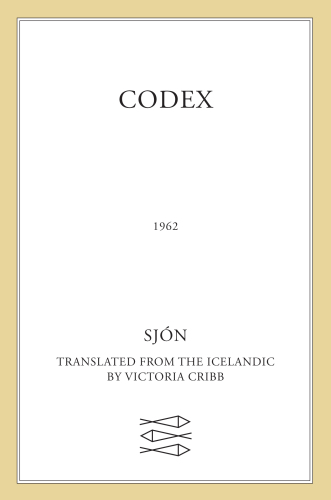
CoDex 1962
A Trilogy
- اطلاعات
- نقد و بررسی
- دیدگاه کاربران
نقد و بررسی

July 1, 2018
A clay figurine becomes human only to join the ranks of those fated to die in a world cursed by division and nationalism.In this beguiling, surpassingly eccentric triptych, Icelandic novelist Sjón (Moonstone: The Boy Who Never Was, 2016, etc.) takes on, in turn, romance (classic, not Gothic), mystery, and science fiction to examine how people parse themselves into little camps and try to make their way through this harsh world. Each part of the (sometimes very loosely) joined narrative offers origin stories--how Reykjavík came to be ("The universal boy found the earth beautiful and shrank his hand so that he could touch it"), how a chicken saved the people of a tiny German village "from being slain by a ferocious berserker who once rampaged across the Continent," how people live and die and are forgotten. The story begins with a Jewish fugitive who, hiding with a German girl, creates a clay child--a golem, that is to say. At war's end, the fugitive makes his way to Iceland. There, as the story shifts into a noirish procedural, Leo Loewe is caught up in a murder case that, among other puzzles, has him trying to distinguish Nazi from mere nationalist--no easy matter, as anyone studying today's headlines will know. Though a stolid Icelander assures Leo that "the Nazis had played truant from modern Icelandic history," it's an observation occasioned by the fact that he's circumcised, as different from his neighbors as his clay creation, who eventually comes to life through curious alchemy. Jósef's transformation comes about in a different world, though, a biotechnological dystopia ruled by "nationalism and greed," to say nothing of corporations and governments making hay of the Icelandic gene pool and strategic location. All humans, Sjón seems to instruct, are wanting, some more than others, but all bound to the same destiny, even as the ghosts of all those who came before await those "dear brothers and sisters, born in 1962," like Sjón himself.Though occasionally reminiscent of David Mitchell, Sjón's work is unlike anything else in contemporary fiction. Strange--but stunning.
COPYRIGHT(2018) Kirkus Reviews, ALL RIGHTS RESERVED.

Starred review from July 23, 2018
Icelander Sjón (The Blue Fox) is something of a cult figure in the English-speaking world—but that should change with his genre-bending volume, a trilogy that has the zealous heft of a lifelong labor. The book begins in Germany in the chaos of World War II, as a Jewish man named Leo Löwe enters into an affair with a barmaid. Together they make a child of a sort named Josef—one made of clay and carried in a hatbox into Iceland. There, Leo gets caught up in a plot involving Nazi gangsters and a conspiracy to steal a golden tooth from the mouth of Leo’s archenemy. In 1962, Leo’s clay son Josef finally awakens and grows into a poet who attends medical school, where he encounters an unhinged geneticist with big plans for Josef, as well as Sjón himself. But all of this is still only half the story, as the main story line is stitched together with excerpts from Viking sagas, fairy tales, and creation myths. In fact, it might make more sense to consider this book an ornate frame story for the fables with which Sjón studs his narrative. Sjón is more than a novelist; he is a storyteller in the ancient tradition, and this work may be remembered as his masterpiece.

September 1, 2018
Reverence for Iceland's rich traditional folklore and anxiety about Icelanders' place in history animate this challenging and cacophonous epic by the talented Sj�n (Moonstone, 2013). The sprawling narrative begins in Nazi Germany, where a Jewish refugee named Leo creates a golem with the young woman who nurses him back to health. The archangel Gabriel looks on, as does a unicorn, and, veering into metafiction, so, too, does the Symbolist who had put together the unicorn . . . a genius indeed. Later, in Reykjavik, Leo finds himself in the middle of a pulpy crime story involving a gold-toothed stamp dealer, an African American theologian, and the possibility of werewolves. In the novel's third section, set in a dystopian alternative present, our golem rises, and an opportunistic geneticist exploits his countryman's precious genetic material. In short, there's lots going on. A firm believer in making readers work for their reward, Sj�n offers an amalgam of creation myth, surrealist absurdity, ancient saga, and contemporary satire that is frequently bewildering. Dedicated readers and Icelandophiles may discover profundity within, and delight can also be found in Sj�n's poetic language.(Reprinted with permission of Booklist, copyright 2018, American Library Association.)




دیدگاه کاربران